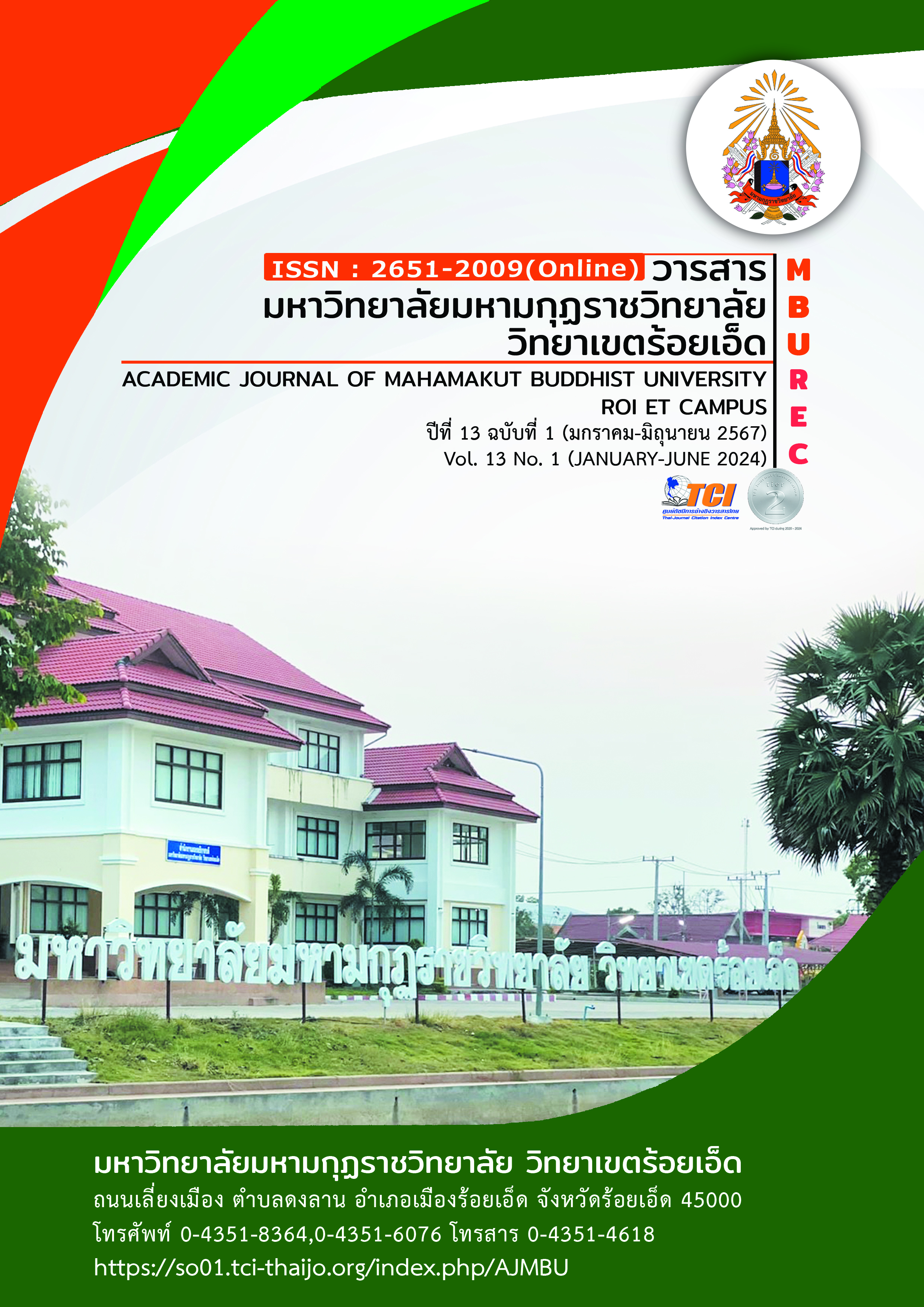THE STUDY OF RESULTS OF LEARNING ENVIRONMENT BASED ON CONSTRUCTIVISM TO PROMOTE GRADE 3 STUDENTS’ PROBLEM SOLVING IN MATHEMATICS
Main Article Content
Abstract
The purposes of the study were to 1) study problem-solving skill of Prathomsuksa 3 students in mathematics class based on Polya, 2) study students’ learning achievement towards Constructivist learning environment, and 3) study students’ opinions on learning environment management on lesson, media, and environment design. The target group was 38 Prathomsuksa 3 students of Khon Kaen University Demonstration Elementary School (Suksasart). The tools used were learning environment based on Constructivist Theory, achievement test in learning environment with 4-multiple choice and 30 items based on Constructivist Theory, and questionnaire on learning environment based on Constructivist Theory including 1) lesson learned detail, 2) interesting and accessible media, 3) environment design, problem situation, lesson objective. The data was analyzed in qualitative and quantitative methods and the statistics used were average ad percentage presented in table and description.
The findings of the study revealed as follows: 1) The result of employing Constructivist learning environment emphasizing on learning mathematics problems of Prathomsuksa 3 students showed that the result of pre-test and post-test of the students were at 20.29 and 23.97 respectively in which pre-test and post-test were statistically different at a 0.5 level of significant. 2) The result of employing achievement test in learning environment showed that there were 37 students (97.38%) who passed the test. 3) The result of questionnaire was appropriate in which there were 94% from the media, 92% from the lesson learned, and 86% from the environment design. The recommendation was declared that well-planned learning environment helped students learn contentedly and search for interesting information by themselves at anywhere and anytime, as well as communicate to their counselor through the platform called EDULEARN which could recognize complex details and solve the problem systematically.
Article Details

This work is licensed under a Creative Commons Attribution-NonCommercial-NoDerivatives 4.0 International License.
References
กระทรวงศึกษาธิการ. (2560). ตัวชี้วัดและสาระการเรียนรู้แกนกลาง กลุ่มสาระการเรียนรคณิตศาสตร์(ฉบับปรับปรุง พ.ศ.2560) ตามหลักสูตรแกนกลางการศึกษาขั้นพื้นฐาน พุทธศักราช 2551. กรุงเทพมหานคร : สำนักงานคณะกรรมการการศึกษาขั้นพื้นฐาน กระทรวงศึกษาธิการ.
กฤตยาณี กองอิ้ม. (2548). ผลของสิ่งแวดล้อมทางการเรียนรู้ บนเครือข่ายที่พัฒนาตามแนวทฤษฎีคอนสตรัคติวิสต์ ในกลุ่มสาระการเรียนรู้วิทยาศาสตร์ชั้นมัธยมศึกษาปีที่ 2. ขอนแก่น : มหาวิทยาลัยขอนแก่น.
จรัสศรี จิณรักษ์. (2554). การศึกษาความเข้าใจมโนมติและการคิดวิเคราะห์ ที่เรียน ด้วยมัลติมีเดีย ที่พัฒนาตามแนวทฤษฎีคอนสตรัคติวิสต์ เรื่อง แรงและกฎ การเคลื่อนที่ของนิวตันสำหรับนักเรียนชั้นมัธยมศึกษาปีที่ 4. วิทยานิพนธ์ศึกษาศาสตรมหาบัณฑิต สาขาวิชาวิทยาศาสตร์ศึกษา. บัณฑิตวิทยาลัย : มหาวิทยาลัยขอนแก่น.
ปกรณ์ ประจัญบาน (2552). สถิติขั้นสูงสำหรับการวิจัยและประเมิน (Advanced Statistics for Research and Evacuation). พิษณุโลก : มหาวิทยาลัยนเรศวร.
พิมพันธ์ เดชะคุปต์ และพเยาว์ ยินดีสุข. (2558). คู่มือปฏิบัติการเพื่อพัฒนาผลการเรียนรู้. กรุงเทพมหานคร : จุฬาลงกรณ์มหาวิทยาลัย.
มเดช บุญประจักษ์. (2540). การพัฒนาศักยภาพทางคณิตศาสตร์ของนักเรียนชั้นมัธยมศึกษาปีที่ 1 โดยใช้การเรียนรู้แบบร่วมมือ. วิทยานิพนธ์ปริญญานิพนธ์การศึกษาดุษฎีบัณฑิต สาขาวิชาคณิตศาสตร์. บัณฑิตวิทยาลัย : มหาวิทยาลัยศรีนครินทรวิโรฒ.
วัฒนาพร ระงับทุกข์. (2542). แผนการสอนที่เน้นผู้เรียนเป็นศูนย์กลาง. พิมพ์ครั้งที่ 3. กรุงเทพมหานคร : วัฒนาพานิช.
วิจารณ์ พานิช. (2555). วิถีสร้างการเรียนรู้เพื่อศิษย์ในศตวรรษที่ 21. กรุงเทพมหานคร : มูลนิธิสดศรี-สฤษดิ์วงศ์.
สถาบันทดสอบทางการศึกษา. (2553). คู่มือดำเนินการสอบแบบทดสอบความถนัดทางการเรียน. กรุงเทพมหานคร : สภาลาดพร้าว.
สมปอง ศรีภิรมย์. (2549). ผลของสิ่งแวดล้อมทางการเรียนรู้บนเครือข่ายที่พัฒนาตามแนวทฤษฎีคอนสตรัคติวิสต์ เรื่อง การแก้โจทย์ปัญหาคณิตศาสตร์ สำหรับนักเรียนชั้นประถมศึกษาปีที่ 5. ขอนแก่น : มหาวิทยาลัยขอนแก่น.
สิริพร อินทสนธ์. (2563). โควิด – 19 : กับการเรียนการสอนออนไลน์ กรณีศึกษา รายวิชาการเรียนโปรแกรมเว็บ. วารสารวิทยาการจัดการปริทัศน์. 22(2). 203-213.
สุภิญ พิทักศักดากร. (2541). การสอนวิชาคณิตศาสตร์ โดยใช้รูปแบบการแก้ปัญหาของโพลยาในโรงเรียนปรินส์รอยแยลส์วิทยาลัย. เชียงใหม่ : มหาวิทยาลัยเชียงใหม่.
สุมาลี ชัยเจริญ. (2551). เทคโนโลยีการศึกษา หลักการ ทฤษฎี สู่การปฏิบัติ. ขอนแก่น : คณะศึกษาศาสตร์ มหาวิทยาลัยขอนแก่น.
National Council of Teachers of Mathematics (NCTM). (2000). Principles and Standards for School Mathematics. Reston, Virginia : NCTM.


